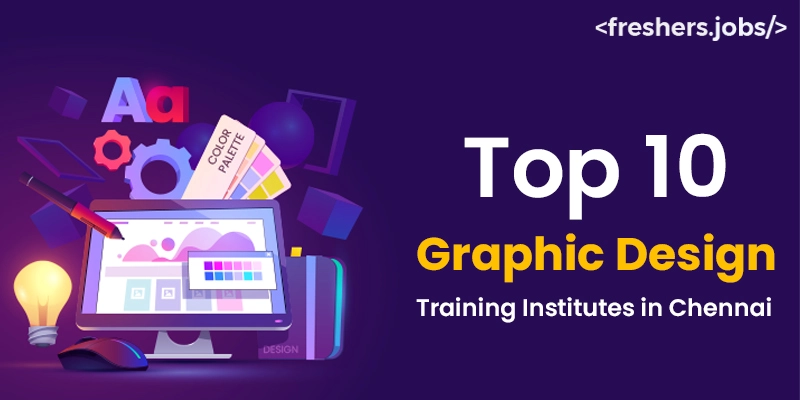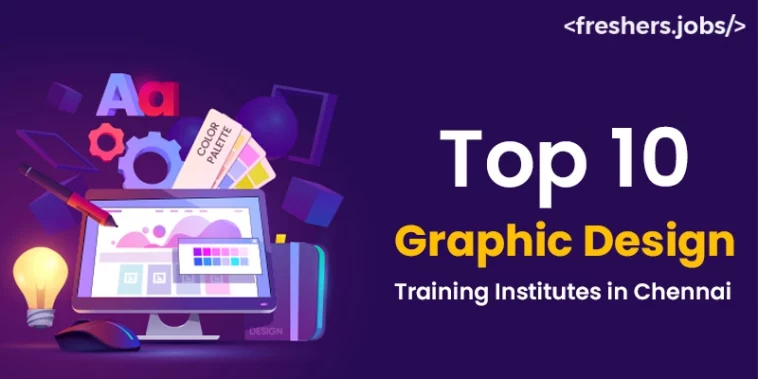Graphic Design is integral to the modern professional world, serving as a linchpin in visual communication strategies. Designers are pivotal in shaping brand identities by creating visually striking logos and comprehensive brand guidelines, ensuring a consistent and recognizable image across diverse platforms. The digital realm sees Graphic Designers influencing website aesthetics, prioritizing user experience and interface design for a seamless online presence.

Social media graphics have become essential tools for engaging audiences, while print and digital collateral, such as brochures and advertisements, demand designers’ expertise in conveying information effectively. The dynamic nature of the field is reflected in the incorporation of motion graphics and video elements for interactive content. We will explore the top 10 Graphic Design Training Institute in Chennai. We will also explore its role, merits, key aspects, and job opportunities in the field.
Listed below are the Top 10 Institute for Graphic Design Courses in Chennai.
- FITA Academy
- IIM Skills
- Simplilearn
- Intellipaat
- Edureka
- Image Creative Education
- WebD School
- Buff Creative College
- And Academy
- Apponix Academy
1. FITA Academy
FITA Academy, a well-regarded institution in Chennai, offers 120+ online and offline courses. The academy consistently maintains its prominent position in the industry, specializing in delivering crucial technical and professional certifications. With a dedicated team comprising more than 1,000 trainers, each boasting decades of experience, the institute has positively impacted the educational journeys of more than 75,000 individuals. Strategically establishing branches in Bangalore, Pondicherry, Coimbatore, and Madurai underscores FITA Academy’s commitment to exceptional training. This intentional expansion ensures that individuals in various regions access high-quality training opportunities.
What makes Graphic Design Classes in Chennai at FITA Academy an ideal choice?
FITA Academy’s Graphic Design Classes in Chennai provide comprehensive training in the fundamental principles of Graphic Designing, offering insights into using relevant industry tools. The courses cover Adobe Photoshop, various tools and palettes, and selection tools such as Marquee, Lasso, and Magic Wand. The training encompasses understanding different image files and formats and knowledge of Color Mode Conversions and their impact on images. FITA Academy offers cost-effective and flexible batch schedules to accommodate both weekend and weekday preferences, and successful trainees can receive assistance in securing job placements.
Tailored Syllabus on Graphic Design Courses in Chennai
The syllabus for Graphic Design Classes in Chennai covers essential topics such as Graphic Designing Essentials, Image Editing with Adobe Photoshop, Basics of Images, Colors, and Shapes, and Working with Selection Tools. It also includes topics like Working with Painting Tools and Brush Settings, Mastering Layers, Texts, Digital Drawing with Photoshop, Channels in Photoshop, Advanced Tools for Image Manipulation, and Advanced Tools for Image Correction. The curriculum covers areas like Working with Digital Photographs, Illustrations with Adobe Illustrator, Basics of Adobe Illustrator, Navigating in Adobe Illustrator, Understanding Artboards, Selecting, Combining and Aligning Shapes, and Managing Shapes and Objects. It also includes knowledge of Applying Transformations, Managing Object Appearance, Saving and Exporting Swatches, Applying Effects, Managing Brushes for Advanced Drawing, Managing Images in Illustrator, Advanced Features of Illustrator, and Working with Graphs.
Expert Trainers for the Graphic Design Training Institute in Chennai
FITA Academy stands out as one of the premier institutes for Graphic Design Training in Chennai, boasting experienced trainers with extensive hands-on experience. These dedicated instructors impart theoretical knowledge and share valuable real-world insights, ensuring that students are well-prepared for the dynamic landscape of Graphic Design.
Project Presentation Sessions
The FITA Academy’s Graphic Design Courses in Chennai includes project presentation sessions to underscore the importance of practical experience in mastering Graphic Design. These sessions enable students to apply their acquired knowledge in real-world scenarios, providing valuable hands-on exposure and enhancing their skills.
Complimentary Placement Sessions
As part of its comprehensive Graphic Design Training in Chennai, FITA Academy offers complimentary placement sessions to support students in achieving their career goals. These sessions cover essential aspects such as resume building, honing interview skills, job placement assistance, and career guidance. With a vast network of more than 1,500 partner companies, FITA Academy facilitates job placements, ensuring diverse opportunities within the industry. This extensive network ensures students have access to promising career prospects, facilitating a smooth and successful transition into the professional world.
2. IIM Skills
IIM Skills is a reputable online platform offering a Graphic Design Course covering fundamental to advanced concepts. While the institute offers diverse courses, their course price might be relatively high when compared to other Institutes.
3. Simplilearn
Simplilearn focuses on delivering Graphic Design Courses to enhance skills and provide valuable industry knowledge. However, the predominant emphasis on online courses may diminish direct interaction between learners and trainers, making it less favorable for those seeking a more immersive learning experience.
4. Intellipaat
Intellipaat specializes in providing Graphic Design Classes for both beginners and advanced learners, featuring a curriculum enriched with valuable learning materials. However, the strong focus on online classes might affect the direct interaction between instructors and students, and the course cost may be relatively higher compared to alternative institutes.
5. Edureka
Edureka specializes in delivering Graphic Design Classes for both beginners and advanced learners, offering a curriculum enriched with valuable learning materials. However, the strong emphasis on online classes might impact the level of direct interaction between instructors and students, and the course cost may be relatively higher compared to alternative institutes.
6. Image Creative Education
Image Creative Education offers comprehensive Graphic Design Classes with real-time assistance. Despite these provisions, it may not be the top choice for individuals seeking a more profound learning experience.
7. WebD School
WebD School specializes in customized Graphic Design Courses designed to meet industry-specific requirements. However, it may not provide an extensive placement support when compared to certain other institutes.
8. Buff Creative College
Buff Creative College provides an extensive Graphic Design course to equip learners with essential skills. However, it may not be the most suitable choice for those seeking a more extensive and profound learning experience compared to other institutes.
9. And Academy
And Academy excels in providing comprehensive Graphic Design Classes covering a variety of concepts. Despite these advantages, the level of placement support provided might be relatively less extensive compared to certain other institutes.
10. Apponix Academy
Apponix Academy is known for providing specialized Graphic Design Classes tailored to industry-specific needs. However, they may not provide a comprehensive practical training when compared to other institutes.
These institutes were thoughtfully selected by Freshers Jobs through rigorous research, considering factors such as brand reputation, student feedback, and a demonstrated history of student accomplishments.
Role of Graphic Designing in the Current Business Environment
Graphic Designing plays an essential role in the current business environment by serving as a visual communication tool that enhances brand identity and messaging. In an era where first impressions matter, compelling and visually appealing graphics are essential for attracting and retaining audience attention. Businesses leverage Graphic Design across various platforms, including websites, social media, marketing materials & product packaging, to convey a consistent and professional image. Effective Graphic Design communicates a brand’s values and personality and influences consumer perceptions and purchasing decisions. It aids in creating a memorable and distinctive brand presence, fostering brand loyalty in a competitive market. Additionally, Graphic Design contributes to the overall user experience, making information more accessible and engaging for customers, thereby playing a crucial role in the success and competitiveness of modern businesses.
What is Graphic Design?
Graphic Designing is referred to as a creative discipline that involves visualizing ideas and messages using various elements that includes images, typography, colors, and layout techniques. It is a form of visual storytelling that combines artistic skills with technology to convey information or evoke emotions. Graphic Designers utilize software tools such as Adobe Photoshop, Illustrator, and InDesign to create visually appealing designs, including branding, marketing materials, websites, and print publications. Graphic Design aims to produce aesthetically pleasing visuals that effectively communicate a message and engage the audience. This multifaceted field requires a keen understanding of design principles, user experience, and the capability to adapt to evolving trends in the visual arts, making Graphic Design an integral part of modern communication and business strategies.
Significance of Graphic Design
- Communication: Graphic Design is a visual language that helps convey messages and information effectively. Whether it’s through logos, brochures, websites, or social media posts, Graphic Design enhances communication by making content visually appealing and easy to understand.
- Branding: Graphic Design is integral to creating and maintaining a brand identity. Logos, color schemes, typography & other visual elements help establish a brand’s personality and make it memorable to the audience.
- Marketing and Advertising: In marketing, Graphic Design is pivotal in creating visually appealing advertisements, posters, banners, and other promotional materials. Visually appealing content has more chances to attract attention and create a lasting impact on consumers.
- User Experience (UX) & User Interface (UI) Design: In the digital age, Graphic Design is crucial for creating user-friendly interfaces & enhancing the overall user experience. This includes designing websites, mobile apps, and other digital platforms to be visually pleasing and easy to navigate.
- Credibility and Professionalism: Well-designed materials often convey a sense of professionalism and credibility. Whether it’s a business card, a website, or a presentation, a polished and visually appealing design can positively impact the perception of a person or a company.
- Information Visualization: Complex information can be made more accessible through Graphic Design. Infographics, charts, and graphs are examples of visual elements that simplify data and make it easier for people to comprehend.
- Cultural Impact: Graphic Design influences and reflects culture, trends, and societal norms. From album covers to movie posters, Graphic Design shapes the visual representation of cultural products and movements.
- Education and Instruction: Educational materials benefit from Graphic Design by making content more engaging and memorable. From textbooks to e-learning modules, visual elements help explain concepts and retain information.
- Accessibility: Graphic Design can also contribute to accessibility by ensuring that information is presented in a way that is understandable to a diverse audience, including those with disabilities.
- Innovation and Creativity: Graphic Designers are often at the forefront of innovation and creativity. They explore new design trends, experiment with different styles, and push the boundaries of visual communication.
Key Components of Graphic Design
Typography
- Fonts: The choice of fonts conveys the tone and personality of the design.
- Hierarchy: Establishing a clear hierarchy through font size, weight, and style helps guide the viewer’s attention.
Color
- Color Theory: Analyzing the principles of color theory, such as complementary or analogous colors, can enhance the visual impact of a design.
- Palette: Choosing a cohesive color palette contributes to the overall aesthetic and reinforces brand identity.
Images and Illustrations
- Photography: High-quality images and photographs can significantly enhance the visual appeal of a design.
- Illustrations: Custom illustrations or graphics can add a unique and personal touch to the design.
Layout
- Grids: Grid systems help maintain consistency and alignment throughout a design, providing a structured and organized layout.
- Whitespace: Proper use of whitespace improves readability and helps to avoid visual clutter.
Composition
- Balance: Achieving balance in a symmetrical or asymmetrical design contributes to its overall harmony.
- Proximity: Grouping related elements together improves organization and clarity.
Contrast
- Color Contrast: Differences in color, brightness, and saturation draw attention to specific elements.
- Text Contrast: Ensuring readable text by contrasting font size, weight, or color against the background.
Brand Identity
- Logo: A well-designed logo is a fundamental element of brand identity and is often a visual representation of a company or product.
- Consistency: Maintaining consistent visual elements across various materials reinforces brand recognition.
Visual Hierarchy
- Focal Points: Establishing focal points guides the viewer’s eye through the design and emphasizes key elements.
- Size and Scale: Varying the size of elements creates visual interest and hierarchy.
White Space (Negative Space)
- Breathing Room: Adequate white space around elements prevents visual clutter and improves overall readability.
- Emphasis: White space can be used to draw attention to specific elements.
Texture and Pattern
- Visual Interest: Adding texture or pattern to elements can create a tactile feel and add visual interest.
- Consistency: Maintaining consistency in texture and pattern helps unify the design.
Alignment
- Orderliness: Proper alignment of elements contributes to a clean and organized design.
- Consistency: Maintaining alignment consistency across the design enhances visual coherence.
Graphic Elements
- Icons and Symbols: Simple graphic elements can convey information quickly and efficiently.
- Lines and Shapes: Using lines and shapes adds structure and visual appeal to the design.
Job Opportunities in Graphic Design
- Graphic Design Intern: Internships provide practical experience for students or recent graduates to learn and apply Graphic Design skills.
- Junior Graphic Designer: Entry-level designers work on basic design tasks under the guidance of senior team members.
- Graphic Designer: Graphic Designers at this level take on more responsibilities, handle diverse design projects, and may work more independently.
- Senior Graphic Designer: Senior designers have a wealth of experience and may lead projects, mentor junior designers, and contribute to strategic design decisions.
- Web Designer: Focuses on designing websites, user interfaces, and digital experiences.
- UI/UX Designer: Specializes in digital product user interface and user experience design.
- Motion Graphics Designer: Creates animated and dynamic visual content for various mediums.
- Brand Identity Designer: Specializes in developing and maintaining consistent brand visuals, including logos and brand guidelines.
- Art Director: Oversees the artistic direction of a project or design team, ensuring visual consistency and quality.
- Creative Director: Leads the overall creative vision of a project, department, or organization, making high-level creative decisions.
- Design Manager: Manages a design team, coordinates projects, and ensures the team meets goals and deadlines.
- Freelance Graphic Designer: Works independently on a project basis, often with multiple clients.
- Entrepreneur/Design Studio Owner: Starts and manages a design studio or agency, handling client projects and building a team.
- Graphic Design Instructor: Teaches Graphic Design at educational institutions, sharing knowledge and skills with aspiring designers.
- UI/UX Developer: Combines design and coding expertise to create interactive, user-friendly digital experiences.
- Creative Technologist: Explores innovative intersections between design and technology, often in research and development contexts.
Graphic Design stands as a cornerstone in the contemporary professional landscape, anchoring visual communication strategies with its multifaceted influence. As designers, we wield immense power in shaping and fortifying brand identities, ensuring a cohesive and memorable presence across a spectrum of platforms. We dived into the Top 10 Graphic Design Training Institute in Chennai and its merits, components, and career opportunities.




